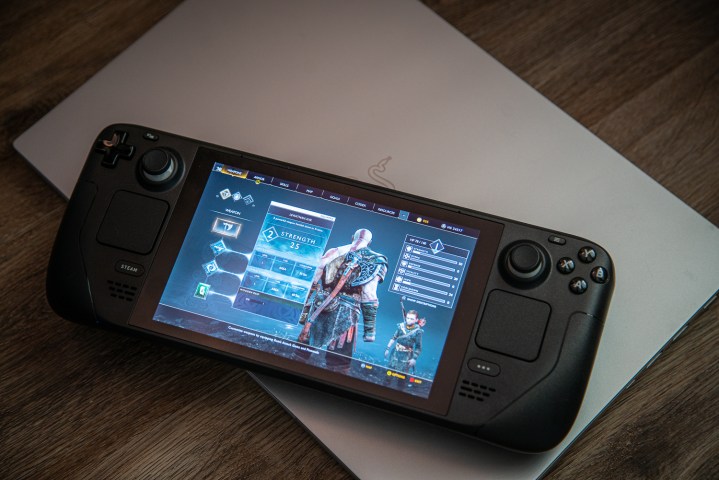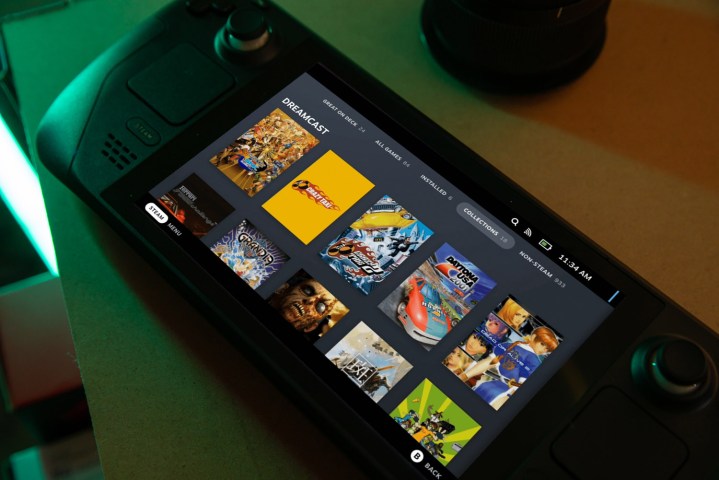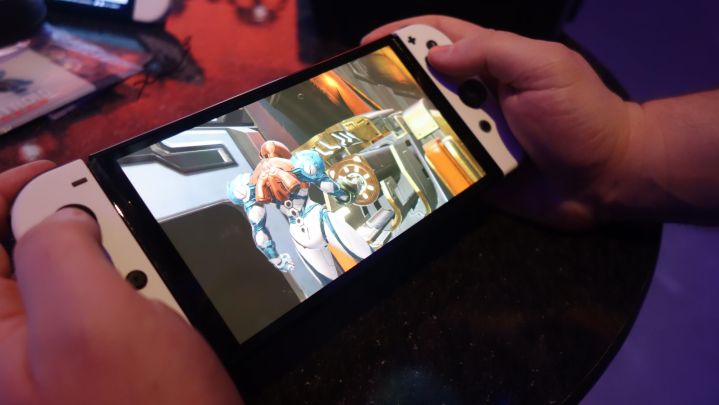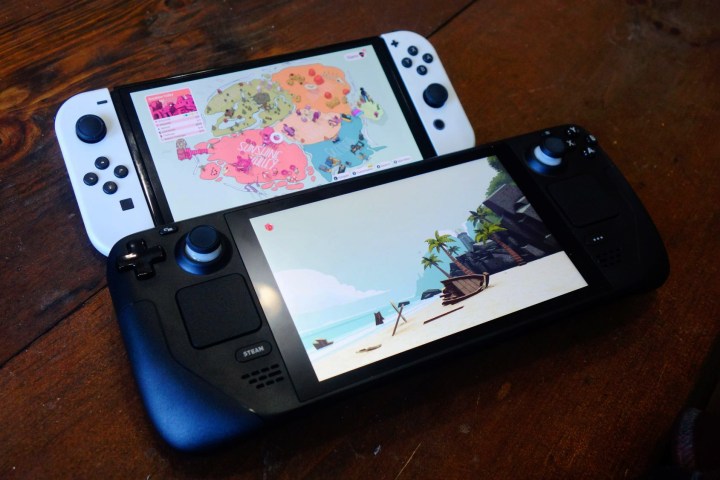Ever since the Steam Deck was but a wee rumor, it’s been inseparable from the Nintendo Switch. It was initially hailed as a “Switch killer” well before it was announced and that distinction only heated up when Valve revealed the device’s impressive specs. Now that it’s finally getting into more players’ hands — and with Valve promising to ramp up production — Steam Deck vs. Nintendo Switch debates are reaching a fever pitch.
There’s a lot to unpack in the heated conversations popping up on social media. It’s a war between ride-or-die Nintendo fans, who are over-eager to defend the company’s honor, and PC loyalists, who are historically loud about touting the power of PC over consoles. It’s also a mutation of a long-running frustration of Nintendo’s hardware shortcomings, which has left players begging for a 4K capable Switch Pro. Mix in all those combustible elements and you get a lot of impassioned arguing.
It’s all a little silly. As someone who owns and uses both regularly, it’s clear that both devices fill different niches. My Steam Deck and Nintendo Switch aren’t competing for my attention; they’re living together in perfect harmony.
How I use my Steam Deck

When I first got my Steam Deck, I wasn’t sure how it would fit into my gaming rotation. At that point, my habits were pretty set in stone. I played consoles at home and used my Switch exclusively in handheld mode. Since both my home and on-the-go niches were filled, it just felt like I’d acquired another big gaming device I’d hardly use.
There were a few hurdles that initially led me to keep my Steam Deck packed away. As a portable device, it’s not terribly portable. Its battery life is notably low when playing demanding AAA games, its screen doesn’t look nearly as good as my Switch OLED, it has a somewhat noisy fan, and the device itself is clunky. While it isn’t heavy, the Steam Deck has a massive form factor that makes it hard to hold comfortably for long stretches of time. When I play, I usually have to rest it on my lap to avoid strain. Because of that, I couldn’t see why I’d toss it in my bag when I left the house over my Switch. And why would I use it at home when I have a PC, PS5, and Xbox Series X?
As the months went on, I started naturally finding my groove, though it wasn’t with power-hungry AAA games. Anytime a new indie game would release that was only available on PC, I would boot up my Steam Deck before my PC, checking its compatibility. I started using it to play games like Rogue Legacy 2, Patrick’s Parabox, and Vampire Survivors. All of those games could theoretically run on a Switch — but they don’t yet. Now I don’t need to wait for a port if I want convenience. Emulation has been a big plus too, as I’m able to access as many old favorites as I want as long as I’m willing to wrestle with Linux.
While it’s more of an indie and retro machine than anything else for me, it’s comforting to know I could run more powerful games on it if I needed to. I struggled to get Elden Ring running on my PC, but I can boot it up on my Steam Deck just fine. It’s not the way I want to play that game and I’d choose console over portable any day for it, but I don’t feel like I’m totally locked out of any game anymore, even ones that are PC exclusive.

The biggest surprise has been that I hardly use it as a true portable. I’ve taken it on flights and the subway, but it’s not my preferred way of playing it. Instead, it mostly taught me how much I dislike playing a game on PC. I’m much happier when I can lay on my couch and casually pick at something than fumble with a keyboard. The fact that I can choose to play something like Teardown in bed is a small, but important change.
My Steam Deck feels like less of a revelation and more like finally digging a corner piece out of a jigsaw puzzle box. It’s a foundational piece of my gaming rotation, one that assures me I’ll always have some level of flexibility no matter the game. It’s not flashy, but it’s something I’ve been craving more since the Switch launched.
How I use my Nintendo Switch

While I use my Steam Deck a lot these days, it hasn’t replaced my Nintendo Switch OLED. I still find that Nintendo’s hybrid console functions better as a portable. A lot of that comes down to its ingenious design, which doesn’t get as much credit as it deserves. When I’m at home, I love that I can pop open its kickstand, undock the joy-cons, and set it down on a table when my wrists start getting tired. It’s still an engineering marvel that I have yet to fall out of love with.
If I have a choice between buying a game on Switch and Steam Deck, I’m always going to run to the eShop first, even if I’m risking a performance dip or paying a few extra bucks. I like holding the thing more and I know I’m going to get a reliable experience, which isn’t always the case with Steam Deck. When I got Soundfall for PC, I was disappointed to find that the game hadn’t been properly optimized for the device yet. I didn’t see any of its cutscenes because they were replaced with TV color bars.
That’s another reason why the Steam Deck functions more like a home console for me. I’ve run into situations where I happily downloaded a game, packed my Steam Deck for a trip, and booted it up only to learn that the game didn’t run. I always need my PC nearby as a safety net.
There are also specific types of games that I just would rather play on a Switch. If I plan on playing a long RPG, one which I’ll mostly be tackling portably, I want my Switch. I’m not going to spend 90 hours playing Persona 5 on a console that starts to strain my wrists after 90 minutes. I’m still excited when I see games like Nier Automata coming to Switch. Even if I can already play them on Steam Deck, I don’t really want to play them there.

It goes without saying that the Switch’s ace in the hole is still its first-party exclusives. The main reason I haven’t abandoned my Switch is that I usually have plenty of big first-party releases to dig. From Pokémon Legends: Arceus to Fire Emblem Warriors: Three Hopes, I haven’t needed an excuse to boot up my Switch in 2022. As long as that continues, only Nintendo itself can replace it.
In the current gaming landscape, there’s a weird pressure to pick favorites. That’s always been the case thanks to the never-ending “console wars,” but it seems to be getting worse the more our options expand. There’s no sense in pitting the Steam Deck and Nintendo Switch against one another because both devices serve different purposes. They’re both imperfect consoles that complement one another.
Like a dad with too many kids, I love my Switch and Steam Deck equally. Each has its own use case that broadens my gaming options, allowing me to play in a way that suits my constantly changing life. Can’t we all just get along?



